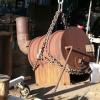
bigfootnampa
Members-
Posts
2,372 -
Joined
-
Last visited
Profile Information
-
Gender
Male
-
Location
Missouri
-
Interests
Blacksmithing, whitesmithing, woodworking, photography, fly fishing, faux painting, fine finishing.
Contact Methods
-
Yahoo
bigfootnampa@yahoo.com
Converted
-
Location
Saint Louis, MO
-
Interests
Woodworking, metalsmithing, photography, fly fishing, carving
Recent Profile Visitors
18,241 profile views
-
Hammer technique critique
bigfootnampa replied to BayardStrachan's topic in Blacksmithing, General Discussion
You are using too big of a hammer for you! Hammering too fast and not hitting with power. Your hammer shape seems poor. Your placement of strikes is not good. You would do better with a two pound hammer. A straight peen or cross peen should do most of your work. You also need to develop skill at using the edges of your hammer. You have lots to learn... some coaching would help. Try to watch lots of videos and to watch skilled smith’s in person when you can. I like a two or two and a half pound hammer for most work. I’m built a little stouter than you. Choking up on your hammer is poor form when you are trying to move metal quickly. Figure out where you want to make a strike... then BRING IT! Your doing the typical beginners whackity whack. Skilled smiths have rhythms more like thumpa thump WHOOMP, thumpa WHOOMP WHOOMP! -
A type of belt that I would really love to source is a good ceramic grit in about 220 or 280. I can get the 220 from one source but it is on a very flexible backer and doesn’t work very well for the precision sharpening that I want to use it for! I need it on a stiffer backer! It seems not to be offered anywhere (I’ve searched a lot)! I bet there are lots who would use it if someone would make it!
-
Resource Center (scrap pile) and useful materials
bigfootnampa replied to Glenn's topic in Blacksmithing, General Discussion
Following up on the bootlaces: my cats have inspired me to develop expertise in repairing the tips! They are obsessed with chewing them off for me! I have acquired a kit of various diameters of clear heat shrink tubing. I can easily retip my laces or make replacements from 550 paracord! BTW I’ve learned that those very long laces on military style boots are pretty handy because you can loosen them without pulling any through the eyes. Never having to relace them saves lots of time! I use an extra tuck on the bow knots and then tye another bow with the doubled bow ends. That uses up all that extra lace and stays tied all day! -
2 x 72 Grizzly or Jantz clone of it.....
bigfootnampa replied to j.morse's topic in Grinders, Sanders, etc
Take a look at the Pheer grinders! I have one and really like it. There are some pretty good DIY kits available now if you can’t swing for something like the Pheer. You can order the critical parts on Amazon or eBay! I’d probably make my own now, but when I bought my Pheer I didn’t know enough to tackle that. -
You guys are the GREATEST! Storm Crow… that’s him! Velegski, I have some 1090. Yes it’s a good steel for me. I once made a carving knife from an old hollow ground circular saw blade that was stunningly durable! Not forged just ground but I did heat treat it. I tempered it with a tiny flame on a propane torch and incredible PATIENCE! I got a blue temper at the spine and straw at the edge! That blade would cut for days before needing sharpened! Thank you Irondragon! What a crew!
-
Wow! I guess I piqued some interest! Thanks to all for thinking and discussing this topic! We used to have a smith on here that made a lot of large chopping blades and sold quite a few to military operators. He noted the double quench if my memory is correct. He used 5160 for most of his blades. I can’t quite remember his name though. I asked about it at the time and was explained that it apparently converted more carbon to austenite. Or… something like that. I expect that I’ll probably get good results by single quenching and tempering, though. I want to make a form of hook knife known as a mocotaugan and to use it carve some pretty hard woods! I might also make some shallow curved hook knives designed primarily for finishing cuts on carved spoons. velegski: I am mostly interested in getting a good hardness with an eye to edge retention. I expect that 5160 will be inherently tough enough for my uses… carving hard woods. What worries me a little is that I might not get my blades to be as durably sharp as I would prefer. It is time consuming to produce a razor sharp polished edge on a shape like a hook knife that cannot be fully worked with power equipment! I mean I insist on extreme sharpness and I disdain softer woods… so I guess that makes me one of those fussy old curmudgeons?
-
Thank you Irondragon! I actually have that on my iPad. I just looked at it though and it doesn’t seem to address my interest in the double quench treatment. Obviously I am using this steel outside of its normal commercial parameters. The hardness values look good for my purposes though! Perhaps I will just skip the double quenching? Around 60 Rockwell seems pretty good for carving woods.
-
Yes Frazer! I quench in oil. I have usually just quenched once and tempered once. I know that some smiths do a double heat and quench. I understand the concept of double tempering too. I’m just wondering about whether to redo the whole quench and temper cycle twice or to skip the temper cycle between the double quenches? I’ll look for a heat treatment guide… but info from a practical smith working often with the material… seems more useful to me.
-
I understand that double hardening can increase the hardening for 5160. My question is: do you then also do two rounds of tempering? Or just two hardening steps and then temper? What I am really after is optimal sequencing for 5160 steel. I am making mocotaugans. Is there any 5160 fans out there with advice for me?
-
Yellow ochre, pencil lead, powdered graphite... these are common jewelers solutions. You can use yellow ochre acrylic artist’s paint. Maybe use a coating or dip and then also put a barrier line of soft pencil lead to help keep the solder from flowing into the clamps? I’ve had pretty good luck applying a slurry of powdered yellow ochre, it’s kind of an anti flux.
-
Some of my axes (picture heavy)
bigfootnampa replied to Latticino's topic in Axes, Hatchets, Hawks, Choppers, etc
I like your splitting axe! I just am impressed by the power of a true wedge shape driven by weight and momentum! Yours looks just about right too. I do find that the axes in my collection are rarely used for splitting though. For firewood a maul is better and when I had a bad arm on one side I actually split quite a bit with a heavy duty froe and hand maul. For more delicate splits... like spoon blanks or tool handle blanks... I generally use a mid size froe. The small froe is also just the thing for splitting chunks of hickory or pecan for the smoker/bbq. -
What did you do in the shop today?
bigfootnampa replied to Mark Ling's topic in Blacksmithing, General Discussion
I quite like the looks of that Ozark hoe! Personally I’d prefer to make the langets by using solid rod and making a u-shape, like a big staple. I guess the downside would be that you couldn’t tighten it after the original installation. If the ends were pointed and bent inward... you could hammer them into the handle and then use wire wrap to secure them! -
looking to identify grandfather's boilermaker tools
bigfootnampa replied to jmalle's topic in Tools, general discussion
Third from last is a webbing stretcher I believe. An upholsterers tool, it stretches the webbing and then the hammer is used to tack it in place. Very similar to a farriers horseshoe nail clinching alligator pliers. -
One wood that no one has mentioned yet is hackberry. Elms in general are probably good. The interlocked grain patterns of elms resist splitting and make for strong handles! Hackberry is particularly flexible and springily compressible... making for good hammer handles that tend to stay tight... I have some that are proven in use! Hackberry root was a traditional favorite for froe mauls.
-
Railroad track is considerably more difficult to bend than 1.25” rebar! During the civil war saboteurs heated railroad tracks in bonfires and bent them around trees... so that they couldn’t be reused! It would certainly be possible to make the type of bends you want by using a trench fire. I suspect that you could coax such bends at black heats far short of red hot! You might even try cold bending them! To cold bend use a sledge and lots of strikes... similar to re-arching leaf springs. A sort of giant bending fork setup on your steel table could also work for cold bending if you use long pieces so that you have good leverage... make lots of small bends... don’t try to get the whole arch at one go.




